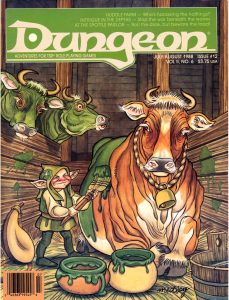
Medieval Mining
Metal brings wealth, technology, and independence in war, so most rulers want their people to mine. Some kings granted prospectors permission to dig wherever they found ore, no matter who owned the land above it. Other kings allowed miners to seize only wasteland that was not being farmed. These laws usually included another provision requiring miners to work their mines. If a mine owner failed to produce ore for nine weeks, the baron often confiscated his holding and awarded it to the informer.
Medieval laws also covered labor in the mines. Shifts could not exceed seven hours, and foremen had to warn workers when their time ended. Bosses communicated with subordinates in deep tunnels by ringing a great bell called a campana, by stamping rhythmically on mine timbers, or by relaying codes of hammer taps from miner to miner. If miners missed these messages, their shifts were still legally over when their lamps burned out. For this reason, foremen filled the miners' lamps and weighed them to be sure that nobody had too little. Most burgomasters refused to allow foremen to work their miners at night or for two shifts in a row, except during emergencies. The miners usually resented these rules, since they wanted two shifts worth of pay.
Many miners fell asleep in lonely tunnels even during a single shift. Miners sang to stay awake, and it's believed that the singing "is not wholly untrained or unpleasing." Dwarves, gnomes, humans, and other races that are not accustomed to eternal existence underground might do the same; the dwarves in J. R. R. Tolkien's The Hobbit sang - and quite well, too.

Ingenious machinery filled medieval mines. Carts were rolled into a mine on tracks using the force of gravity, then pulled out by mules or pack dogs. (In fantasy game terms, pack dogs are treated as war dogs and carry 20 lbs. at normal speed or 50 lbs. at half speed.) Outside the mine, daredevil sledge drivers guided loads of ore down mountainsides, steering themselves with poles.
It's mentioned that these sledders worked "not without risk of life." Other loads were lifted out of vertical mine shafts by cables. Hand-powered windlasses and cranes operated by treadmills dotted the ground above mines. Miners did not even have to climb down the shafts to work. They slid on chutes or clung to rope elevators powered by treadmills.
Some mines flooded constantly, so organlike pump arrays descended into the tunnels, powered by treadmills or water wheels in nearby streams. Some pumps used a single plunger, while others in-volved dragging a chain with bundles of watertight leather set at given intervals through a pipe. Pumps become inefficient when the distance they travel is too long, so deep mines used other systems. Some dragged chains with buckets attached through the water. Others required pump relays, each one raising water one level using buckets or Archimedes' screws. Relayed pumps could use relayed water wheels, in which water poured down a deep shaft and turned a different engine on each floor.
Oxygen: A Miners Best Friend
Nothing could be more important than oxygen to miners of any race. Medieval engineers dug horizontal shafts into mountainsides so air could flow freely into some mines, but many lodes were too deep to be reached in that manner. In windy spots, miners used funnels and pipes on the surface to ventilate tunnels. These devices had fans that rotated in the wind using vanes and sails. Deeper tunnels required miners to invent various air pumps, including men fanning air into shafts with linen sheets, feathered propellers, vast blower boxes powered by water wheels, and gigantic bellows. Gearboxes allowed these air pumps to be powered by treadmills or water wheels as well as by hand.
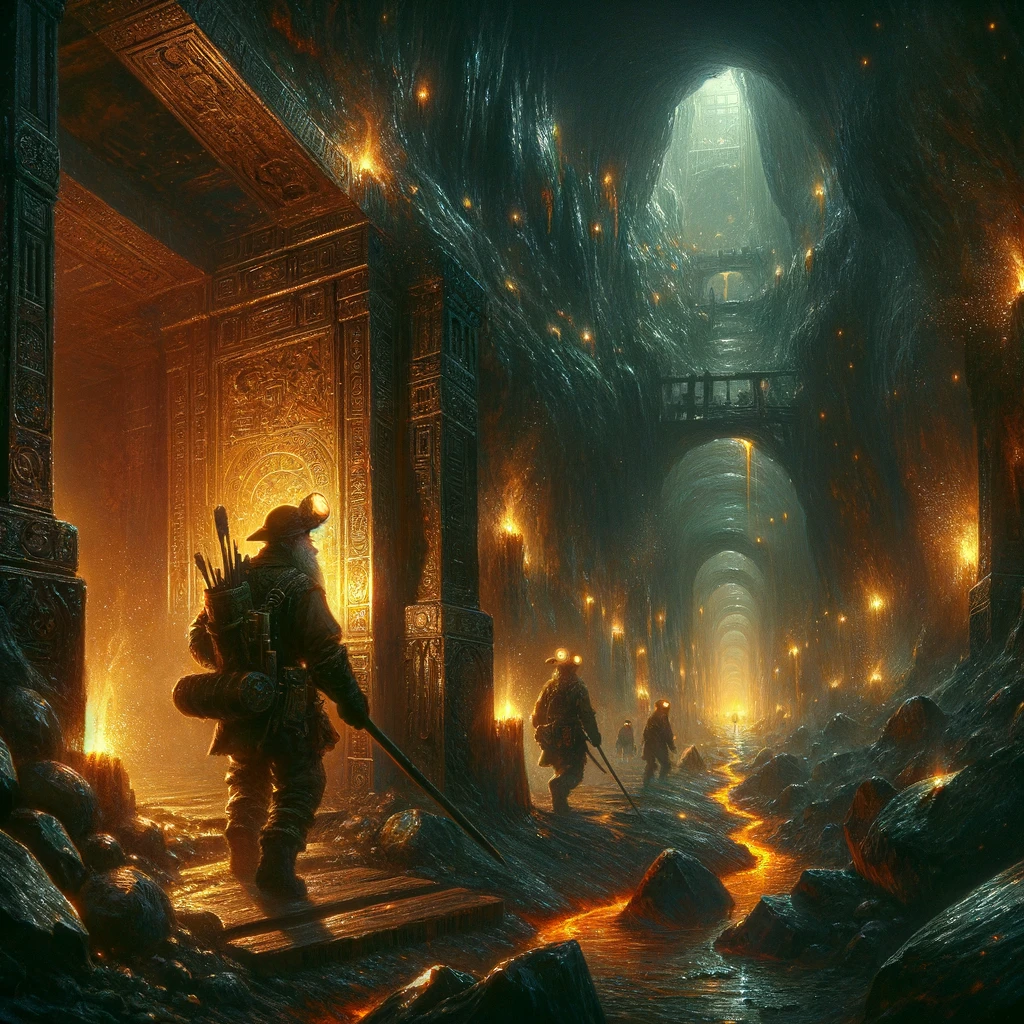
When these devices break (or are sabotaged) in game campaigns, characters might be trapped without fresh air. A 10′ cube could contain enough oxygen to last one man for one day. If the character exerts himself by exploring, fighting, or digging, he needs twice as much oxygen.
Fires also consume oxygen. A torch consumes a 10′ cube of oxygen in eight hours, and a small bonfire uses this much in two hours. Burning oil uses 10 times as much oxygen as a wood fire, so an oil-burning fire uses up a 10′ cube's oxygen in only 12 rounds. An adventurer can hold his breath for a number of rounds equal to one-third his constitution, rounded up. After this, the character must attempt a 1d20 roll against his constitution each round, with a penalty of 2 per round. When this roll fails, the victim suffocates.
Other Perils of the Underground and Mining
In the gloomy depths of the medieval mines, miners were convinced that they were never alone-that malevolent demons and eerie gnomes lurked in the labyrinthine tunnels alongside other dark and unnamed horrors. While some of these subterranean spirits appeared harmless, their actions belied an unsettling intensity. They seemed to be ceaselessly excavating ore, yet mysteriously, the veins never diminished. These uncanny beings, sensitive to mockery, would retaliate by hurling stones at any miner audacious enough to taunt them.
Yet more sinister were the invisible entities, whose ghostly knocking sounds reverberated throughout the tunnels, filling the hearts of miners with dread. Then there were those malevolent specters that demanded ritualistic offerings, guarding their cherished ore veins with a zealousness that suggested consequences too dire to contemplate for those who dared to dig without appeasing them first.
In the chilling underworld of the mines, the penalty for ignoring these spiritual demands was swift and merciless. Those who dared to defy the spirits by withholding offerings were invariably met with a grim fate-either plummeting to their death down an abyssal shaft, being swallowed by the earth in a catastrophic cave-in, or falling victim to some other unspeakable calamity that lurked in the shadowy recesses. Yet, paradoxically, these same spirits would guide the benevolent and generous to untold riches hidden within the earth. In the realm of fantasy, such capricious entities might manifest as pech, booka, or subterranean pixies.

But it was the more malevolent beings that truly chilled miners to their bones. The kobolds were the stuff of mining nightmares-small but malevolent figures thought to be nearly impossible to eradicate from the tunnels. Legend had it that these insidious beings reveled in sabotaging elevators, sending unwitting miners plummeting into the abyss below. Furthermore, miners believed that these mischievous kobolds were master tricksters, substituting precious silver veins with cobalt-a worthless, gray metal that would later find uses in alloys and paints. This deceptive switch left many a miner cursing the darkness, and forever questioning the very ground upon which they tread.
Mine Dusts
In the shadowy recesses of the mines, an insidious menace awaited in the form of fatal ants and solifugae-microscopic spiders with a venom so potent it could incapacitate even the most seasoned miners. A chilling belief prevailed among those who dared to venture into these subterranean mazes: each mine harbored its own distinct species of venomous critters. The poison they carried spread like wildfire through the veins, rendering its victims helpless and in excruciating pain.
Adding to the tension, lore whispered of a single antidote-a hidden hot spring tucked away in the heart of the very mine that housed these malevolent creatures. This mystical wellspring of healing water was the subject of many a miner's desperate search, its existence elevating the level of peril in the already-dangerous underground passages. Dungeon Masters might relish the opportunity to weave this elusive fountain into their unfolding narratives, adding yet another layer of urgency and suspense to the labyrinthine underworld.
The rocks and soils that miners dig can kill them, too - and it does so in real life. Ordinary dust scars the windpipe and causes lung diseases in old age. Other powders corrode the lungs at once, and Agricola reported that in the Carpathian mountains most women married at least seven husbands, as one by one each man smothered underground. A black dirt called pompholyx settled in open wounds and ate them to the bone.
It also destroyed iron, so wooden tools were used in the mines it infested. Cadmia dust does even more harm; it can burn into uninjured skin when moistened. A greenish metal called kobelt was said to devour the feet of men who walked over it. This was the origin of the word "kobold," because people assumed that little goblins laid kobelt traps on purpose. Miners protected themselves from these dusts with sealed leather coveralls and breathing masks made of animal bladders.
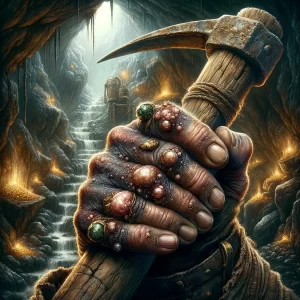
Pompholyx
Miners could find Pompholyx to be quite the unwelcome plus-one in their underground endeavors. You see, the mining environment is like a VIP lounge for the factors that invite Pompholyx to the party. Frequent exposure to metals like nickel, cobalt, and chromium, which are often part of the mining scene, can be a direct ticket to breakout city for those prone to this skin condition.
Moreover, the combination of sweating from the physical labor and wearing protective gloves for hours can create the perfect hot and humid environment that Pompholyx loves to thrive in. It's like setting up a spa day for those itchy blisters right in the middle of a miner's hands and feet.
Poisonous dusts like pompholyx do no harm to healthy characters, but they infect any wound that is not bound within one round after contact. Pompholyx causes 1 hp damage per round to such open wounds until half again as much damage is taken as the character originally suffered. Any iron exposed to pompholyx (including armor) must save vs. acid every hour or be damaged. Armor loses one armor class of protection; weapons suffer a - 1 on damage rolls, and small items break. Intelligent enchanted swords plead not to be exposed to pompholyx.
Cadmia dust (metal powder dust) causes 1-4 hp damage per round, or 1-8 hp damage if the victim has wet skin. Kobelt destroys boots after 1-10 turns (if not brushed off) and causes 1 hp damage per round to bare feet. When characters stand on kobelt without shoes, they must save vs. poison (DC relative to exposure) or be unable to stand thereafter until their wounds are healed, otherwise falling to the ground in the kobelt for 1-10 hp damage. Kobelt might also be green slime.
Protective clothing prevents damage from dusts, but such clothing is useless once perforated. Whenever a PC suffers damage, he must make a dexterity check on 1d20 to protect his suit (DC relative to exposure).
People who get any corrosive dust in their eyes (for whatever reason) must save vs. poison or go blind (rolling a natural 1 on a 1d20, or not beating a DC of 14, temporarily for 3 minutes if immediately washed out with water, else 1 hour). Dusts have a 20% chance of affecting both of a person's eyes even if only one eye is exposed, due to sympathetic eye syndrome.
Dangerous Fumes
Navigating the mines was like playing a treacherous game with Death itself-where even the air you breathed could betray you. Stagnant pockets of air could be ventilated with pumps, but lurking in the gloom were far deadlier threats: insidious, poisonous gases that stole lives without warning.
Ingenious methods were deployed for detection; candles, when burned, shifted colors in the presence of certain noxious fumes, while canaries served as tragic sentinels, their tiny lives sacrificed in the detection of lethal methane gas. Using open flame to test for methane was a gamble of the highest stakes, a dance on the edge of a blade-do it wrong, and you'd trigger a cataclysmic explosion.
And yet, the very techniques used to crack open the bountiful veins of ore were also the breeding ground for an ever-present danger: carbon monoxide. Workmen would light underground bonfires, filling the rocky chambers with heat to expand and then crack the stubborn rock with the shocking chill of cold water.

This primal dance of fire and water, though essential, produced the gas as a deadly byproduct. Every time the miners struck flint to steel, they knew they were flirting with an invisible reaper-hoping their precautions would be enough to keep it at bay, but knowing that a single misstep could summon it forth.
Miners usually did this chore on one day, evacuated their tunnels, and did not return until 2+ days later. Some smoke settled on water, forming an arsenic film that floated into the air when the pools were disturbed. Those who survived the fumes reported that their limbs swelled until their hands and feet were spherical. Agricola reported watching men climb ladders to escape arsenic gas, only to fall as their fingers grew too bloated to grip the rungs.
Sulfurous fumes, present with volcanic activity, suffocate victims as if there were no oxygen in the air. Carbon monoxide smothers any character in only 1-3 rounds because of its potent poisons: Anyone exposed to arsenic gases must save vs. poison (DC 8); if the roll fails, they are immobilized by swelling.
Arsenic also smothers victims as if it were carbon monoxide. When this material settles in pools, characters can walk past safely. However, when anything disturbs the water, gas is released. If a character actually touches the water, they must save at -3 against a DC 11 or be paralyzed and begin to choke. Furthermore, anything wetted with arsenic-tainted water exudes poisonous gas in a 10′ radius until it is scrubbed.
Some PCs may want to use these chemicals against enemies. If so, the Master should remember the dangers of carrying these poisons and being caught in one's own gas. None of the gases but arsenic have any effect aboveground in open air. Even inside buildings, they disperse too quickly to kill most people, given an open window or two.
The corrosive dusts cannot cause full damage except when concentrated. A few handfuls of kobelt or cadmia should be treated like the acid. Pompholyx cannot harm living things aboveground. PCs might use it to sabotage iron objects, but it would have to be applied directly and allowed to sit undisturbed for one hour.
Dig Out of Mines
In the perilous world of mining, the ever-looming specter of disaster is the catastrophic collapse of the earth itself. In the fantastical realms of fantasy campaigns, the mathematics of survival are harsh yet clear: Tunnels must be reinforced with timbers or stone at intervals no greater than every 10 feet. Constructing these vital pillars of safety isn't a trivial task-it demands four man-hours of grueling labor for each support.
And that assumes you've already solved the logistical nightmares of sourcing the wood or stone and then hauling it down into the bowels of the earth, where darkness swallows all hope and the walls themselves seem to press in on you.
Even with these safeguards, the mine is a living, breathing entity of risk. With every pickaxe strike and every torch flicker, there's a haunting 2% chance per day that somewhere in that labyrinthine maze, the earth will give way, trapping or crushing anyone unfortunate enough to be in its path. Without these supports? Those odds skyrocket, and each passing moment becomes a roll of the dice with fate.
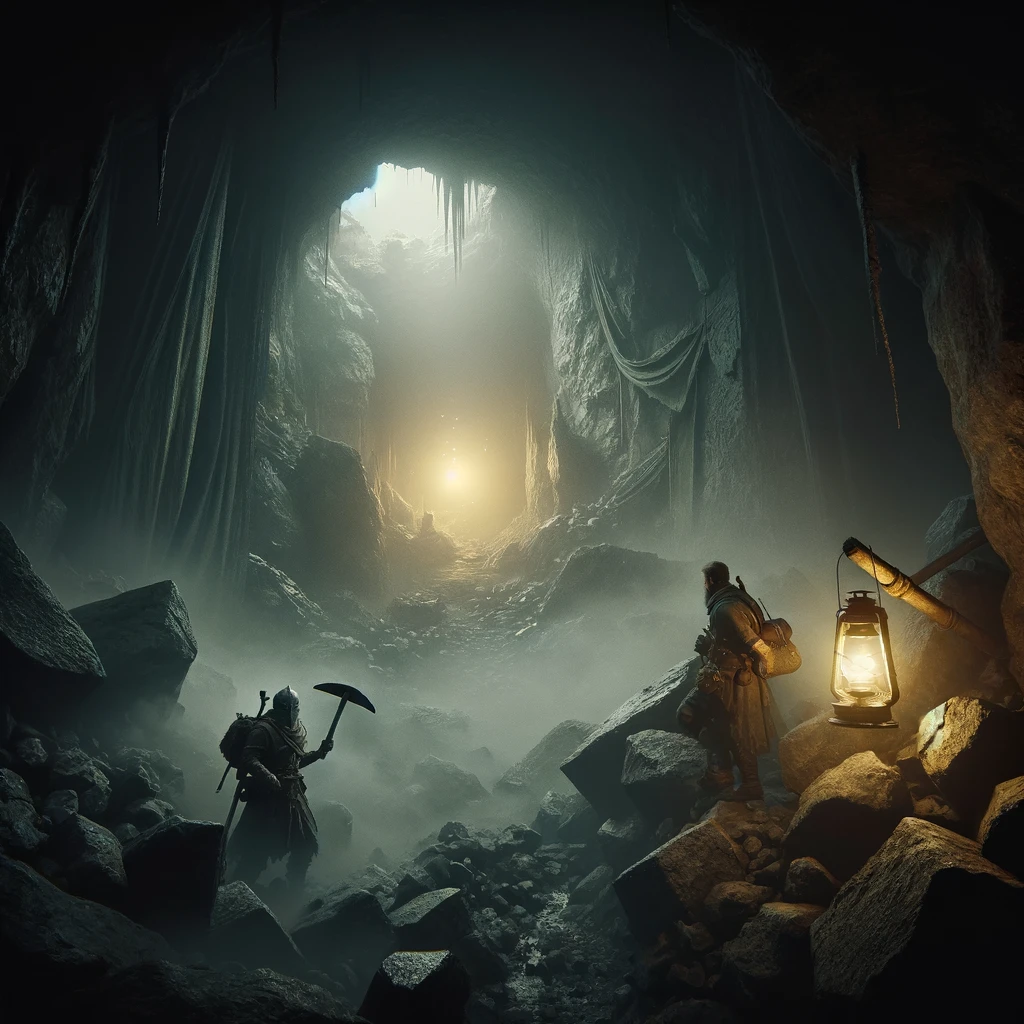
There's a staggering 10% chance per turn that a tunnel, once thought to be secure, will collapse in a roar of falling stone and a cloud of choking dust. It's as if the very walls of the mine are an ever-changing puzzle, constantly reshuffling, and a single wrong move could spell your doom.
The Master should decide where the cave-in occurs, placing it wherever miners have weakened the ceiling most recently. Damage from falling rocks. Even if cave-ins miss characters entirely, they may trap the PCs underground. Below shows how fast rescuers can dig. Victims may try to scoop their way out, but unless they have picks and shovels, they dig at one-quarter the usual rate.
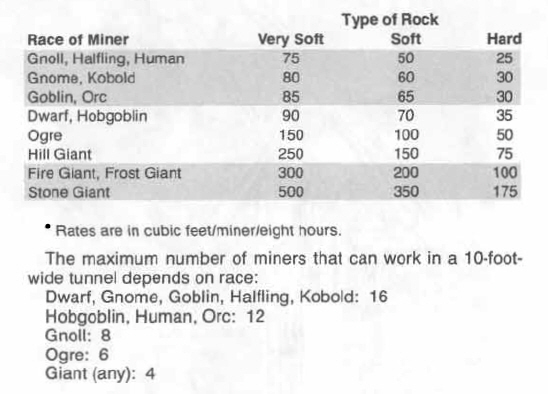
Dungeon and Cavern Odors and Gases
In the dark abysses of fantasy and other mystical role-playing realms, death lurks around every corner. Among the most treacherous and sinister dangers are the Poisonous and Noxious Gases. Born from the very bowels of the earth, these gases can be as lethal as the venomous fangs of ancient serpents.
Volcanic upheavals can unleash terrible clouds of Sulphuric gas, every whiff a death sentence. Even the rot and filth of a dungeon's waste can manifest into lethal miasmas, like methane, whose odors claw at the senses, leaving characters gasping for air.
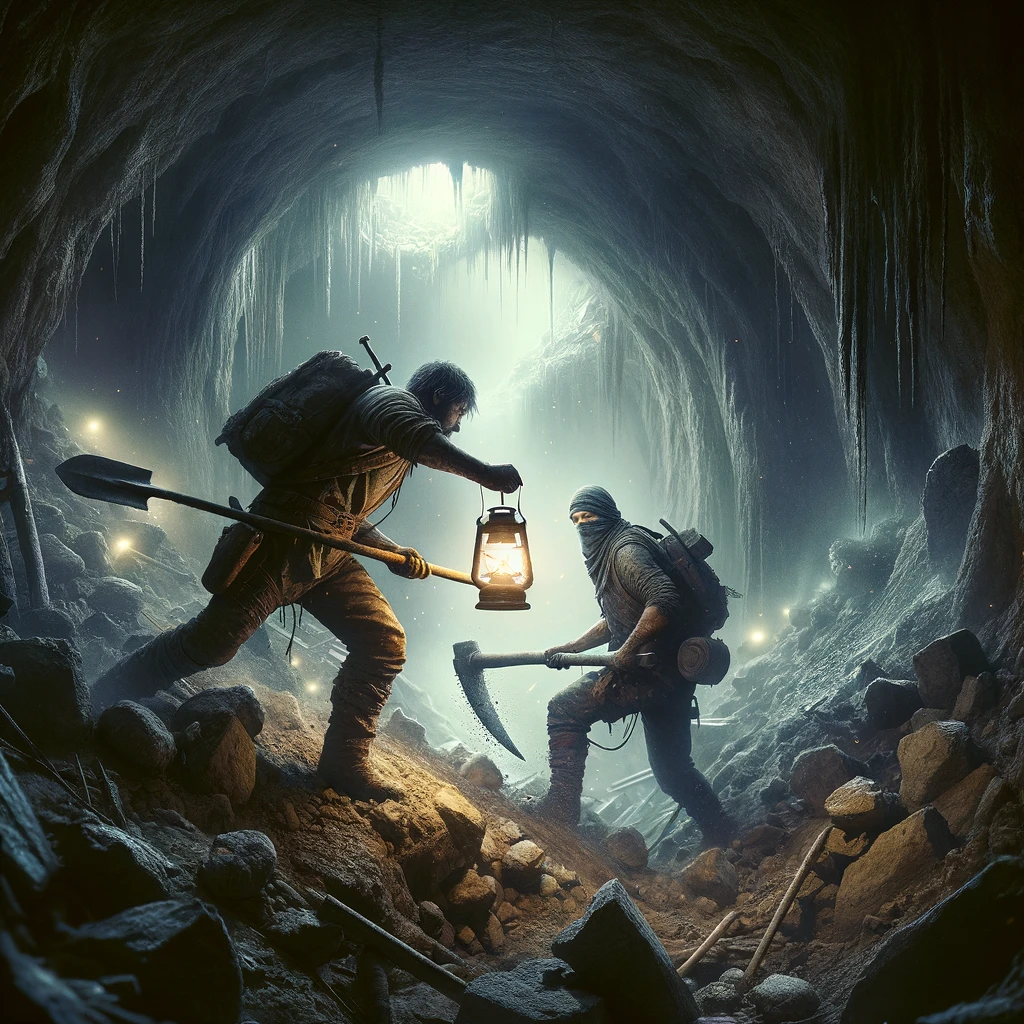
In the hands of a cunning Master, these gaseous menaces are not mere atmospheric elements. They are weapons, traps to be sprung at the most unexpected moments. Characters must be ever-vigilant, rolling saving throws vs. poison, or else fall prey to a slow, choking demise. Noxious gases demand Constitution Checks every pulse-pounding round, failure of which erodes their very essence, impairing attacks and abilities. Though it won't kill them outright, characters can be rendered pathetically helpless. Only fresh air can restore them, at the rate of three per turn.
Such toxic threats as tear gas fall into this malevolent category, but the dangers don't stop there. Gases like natural gas may be silent and unseen killers, possessing mild or no odor at all. Characters must make Wisdom Checks, sensing the unseen peril just in time, or find themselves caught unawares.
Then, there are those gases that scream danger, like Sulphur. Their stench is a warning, a chance to brace for the coming onslaught.
Natural gas, often found where coal and oil whisper their dark secrets, hides an explosive wrath. A mere torch, candle, or lantern may ignite a furious explosion with a base 20% chance per round, dealing 1d6 damage to all within the blast radius. More concentrated or different explosive gases can have their explosion chance and damage modified by the Master, increasing the potency and terror.
The small, innocent creatures, such as birds, are the most vulnerable to these toxic clouds. A bird's death could serve as an eerie harbinger of doom, with secret saving throws made by the Master to determine their fate.
Ventilation
A breath of salvation or a trap of doom?
Well-ventilated areas may dissipate the threat, halving the duration of gas-based spells and clearing poisonous or noxious gases quickly. But not all air is a savior. Moderately ventilated areas may conceal dangers for an hour, and completely sealed or unventilated regions may trap lethal mists for a full 24 hours.
Smoke, large fires, and the very breath of characters themselves can alter these dynamics, changing the nature of the peril and the rate of its accumulation.
Strategies for Ventilation
- Natural Ventilation: Miners often take advantage of natural airflow. They will design mines with entrances and exits aligned with the prevailing winds or use the natural topography to encourage air to flow through the mining tunnels.
- Shafts: Vertical or slanted shafts could serve multiple purposes, including ventilation. By creating these shafts at strategic points, miners could help fresh air to circulate through the mine. The difference in temperature and pressure would help draw fresh air into the mine and expel the stale air.
- Manual Methods: In some cases, especially where natural ventilation was insufficient, miners will resort to manual methods. This could include the use of fans made from large leaves, fabrics, or other materials to manually waft fresh air into deeper parts of the mine.
- Fires: An ingenious method used involved creating fires at the base of shafts. The heat from the fire would cause air to rise, drawing fresh air into the mine through other openings. However, this method had to be used cautiously to avoid consuming too much oxygen or increasing the risk of fire.
Odor Detection
A final bastion of defense or a harbinger of doom?
Miners rely heavily on their senses and natural indicators to detect odors and the presence of dangerous gases in mines, as they don't have the sophisticated detection equipment.
The nose knows danger, but it is a fickle ally. The Master must make Wisdom Checks for characters, and even dogs (with a Wisdom of 16) may aid in this desperate gamble. But a failed check can lead to disaster. The type of odor, its distance, and even the training of animals can play a crucial role in detecting or ignoring the lurking peril.
Strategies to Detect Odors
Not foolproof and carries risk.
- Sense of Smell: The most direct method is simply using their sense of smell. Certain gases, like hydrogen sulfide (which smells like rotten eggs), could be detected by their distinctive odors. However, this method has obvious limitations, especially with odorless gases like carbon monoxide.
- Flame Lamps: Miners use flame lamps not only for illumination but also as an early form of gas detection. Certain gases change the color of a flame or cause it to flicker differently. Observant miners can notice these changes and deduce the presence of gases. For example, methane (firedamp) makes a flame burn bluer, and its presence could also cause the lamp's flame to elongate.
- Canaries: While more commonly associated with coal mining, the concept of using animals to detect dangerous gases goes back many, many ages. Canaries, and other small animals, are more sensitive to toxic gases than elves or humans. Their distress or death in mines would serve as a warning sign of dangerous gases like carbon monoxide.
- Dampness and Air Flow: Miners are also attuned to changes in air quality, including dampness and airflow. A sudden drop in temperature or change in air movement could indicate the presence of water or gases seeping into the mine.
- Taste and Irritation: Some gases and vapors can cause a metallic taste in the mouth or irritation of the eyes and throat. Miners might use these physical reactions as clues to the presence of certain vapors or gases.
Dungeon and Cavern Cave-ins
In role-playing games the cave-in, the collapse of the ceiling, let it be in a cavern or a dungeon, in a temple or ruins, is a great risk to the party of players. Cave-ins are unique to the underground environment. Although not a common occurrence, the chance that the roof of an underground location may cave in is something that must be considered, especially if characters are excavating, using explosive magic, or otherwise placing stress on the overhanging rock.
Although the usual effect of a cave-in is to bring the roof of an area crashing down upon its inhabitants, cave-ins can also endanger characters in other ways. For example, a bridge that characters are crossing may collapse, or a floor may give way, dropping those who were standing on it amid tons of jagged, crushing rock. Characters may even try to trigger a cave-in as a means of attacking an enemy; such attempts must be made cautiously, however, since a cave-in may create a chain reaction that collapses a far larger area than intended.

Causes of Cave-ins
Most underground settings are solid enough not to collapse unless subject to a great deal of external pressure. In general, a strong cavern, dungeon, or realm is only susceptible to cave-ins as a result of natural disasters such as floods, earthquakes, or volcanic eruptions. Certain magical spells that duplicate these natural disasters can duplicate their destructive effects as well. A raise water spell that creates a flood in a tunnel, for example, should be treated as a natural flood. In the case of a major natural disaster, the Master's judgment must be used to determine the exact area of effect.
Although the guidelines in this section serve to give an idea of what might occur during a cave-in in a specified area, the far-reaching effects of a major earthquake might actually annihilate an entire subterranean realm. Occasionally underground areas are ripe for cave-ins. Perhaps aging has caused much of the supporting rock in an area to crack and crumble, leaving only a thin area of solid support-or maybe a recent earthquake or flood has left an area so weakened that only a slight additional bit of pressure is required for the entire area to fall inward. Such areas should be noted when the maps for an underground area are prepared.
Accidental Causes
Only the frailest of underground locations are susceptible to accidental cave-ins. These collapses are triggered by the weight of a creature walking across a weak spot, or even by the sounds created by characters or creatures. Based on the weakness of the area under consideration, the Master should assign a percentage chance of a collapse occurring. A ledge, for example, might have eroded to the point where it has a 5% chance of collapsing per character crossing it. This chance should be modified if the characters are very heavily laden or accompanied by mules or other creatures. The chance may be doubled if the characters run across the ledge, since the pounding is much harder than if the party walks slowly.
If the characters participate in melee combat on such a fragile surface, not only must the weight of all participating creatures be figured in (figuring carefully the weight of nonhuman creatures such as ogres), but the chance of a collapse should be doubled because of the additional pounding that the surface takes. In cases where the weakened area is not directly beneath the characters, the chance of a cave-in is reduced. Unless the characters apply weight to the area, sound is the only other likely avenue for causing an accidental collapse.
An area that could be triggered into a collapse by sound waves is very fragile indeed! The intensity of the sound must be considered, with a percentage chance of collapse assigned according to the loudness and sharpness of the noise. For example, an area might stand no chance of collapsing under the sound pressure of normal conversation, but the clashing of swords in combat might give a 1% chance per round of a cave-in.
Cave-ins Caused by Excavation
Whenever characters or creatures are digging into the earth, they run the risk of excavating away a significant support for the ceiling, causing a cave-in. Mining is the most common cause of this type of cave-in, and precautions such as shoring up an excavated passage are usually taken by the miners. More details on these procedures are provided later in the rules for mining.
Characters trying to dig an escape tunnel or clear rubble from a previous cave-in are often unable to properly shore up their excavated passage. In this case, weakened surfaces stand a fair chance of collapsing. Generally, the possibility of a cave-in under such circumstances is about double that of an accidental cave-in. There is about a 10% chance per turn that a weakened ceiling or tunnel wall collapses during excavation.
Cave-ins Caused by Sabotage
It is not unusual for characters or underground denizens to intentionally weaken an area so that it caves in at an opportune time-at least, opportune in the minds of the saboteurs. As with all types of cave-ins, the success of an attempt to purposely weaken a structure or surface depends on the inherent strength of the area. Many areas subject to such sabotage collapse on the heads of the saboteurs themselves.
Columns that support a ceiling, bridge supports, or narrow layers of rock over which characters or creatures walk are obvious targets for sabotage. To chip stone away to the point where a collapse is likely requires some skill at stonework and a little luck. A character must have miner proficiency to have a decent chance of successfully sabotaging an underground area. A character without miner proficiency who makes a sabotage attempt should have a 1/3 chance of successfully completing his task, a 1/3 chance of leaving the structure too strong to collapse, and a 1/3 chance of bringing it down upon themselves. A character with miner proficiency has a 2/3 chance of successfully sabotaging the area, and a 1/6 chance of not damaging it enough, and another 1/6 chance of damaging it so extensively that it collapses during the sabotage attempt.
Of course, an area-or at least the stone that supports an area-must be reached in order to sabotage it. The soaring ceiling of a vast underground chamber is very difficult for a character to damage. The columns that support that ceiling are much more accessible. These attempts take considerable time and create quite a bit of noise. See the excavation rules (page 50) for an indication of how long it might take for a character to chisel his way through a column that is three feet in diameter. The Master must determine how much work must be done to sabotage a structure.
Random Occurrences of Cave-ins
If a campaign focuses on the underground for extended periods of time, the chance of a naturally occurring cave-in affecting the characters increases. Even though the chance is not very great at any given moment, if characters spend enough time underground, they are certain to eventually encounter some sort of cave-in.
The base chance for a cave-in during the course of the characters' underground exploration is 1% per day. On long expeditions, the Master may wish to alter this roll to a 10% chance rolled every 10 days.
Cave-ins just don't happen on top of characters and their party: it could happen behind, in front of, out of sight, but in hearing range, an entrance, an exit, etc.
Cave-in Chain Reactions
Many things can go wrong for the characters if there is a chain reaction. A significant menace is created when even a small section of an underground location caves in, even if the cave-in does no immediate harm. The force of gravity is constantly attempting to work its destruction on the ceilings of the underworld; even a small cave-in can so weaken supporting structures that a massive chain reaction of collapse begins immediately or threatens an area in the near future.
Mines and Metallurgy
In the heart of every dwarf lies an unbreakable connection to the deep and echoing mines. As the venerable Agricola once declared, "The discovery of ore and the relentless pursuit of digging it up stand as paths to untold riches, rivaling the glittering treasures of legend. The thrill of striking a vein of precious metal is an intoxication, a passion that burns bright in the stout hearts of dwarvenkind."
But mines are more than mere sources of wealth; they are labyrinths of mystery and danger, hidden realms that beckon the bold and the curious. They transform into ideal "dungeons," where the shadows hide more than just rock and earth. Adventurers, those restless souls with a hunger for the unknown, find themselves drawn to these subterranean mazes. Abandoned tunnels whisper tales of ancient secrets, while active shafts resonate with the echoes of foes or nightmarish creatures lurking below.
Every strike of a pick, every glimmer of a gem, tells a story. It's a symphony of ambition, courage, and the insatiable desire to uncover what lies beneath. In the mines, darkness holds not only the promise of wealth but also the allure of adventure. For those brave enough to explore them, the mines offer gateways to worlds uncharted, where the line between fortune and folly is as thin as a miner's hope, and the pulse of the earth itself guides the way.
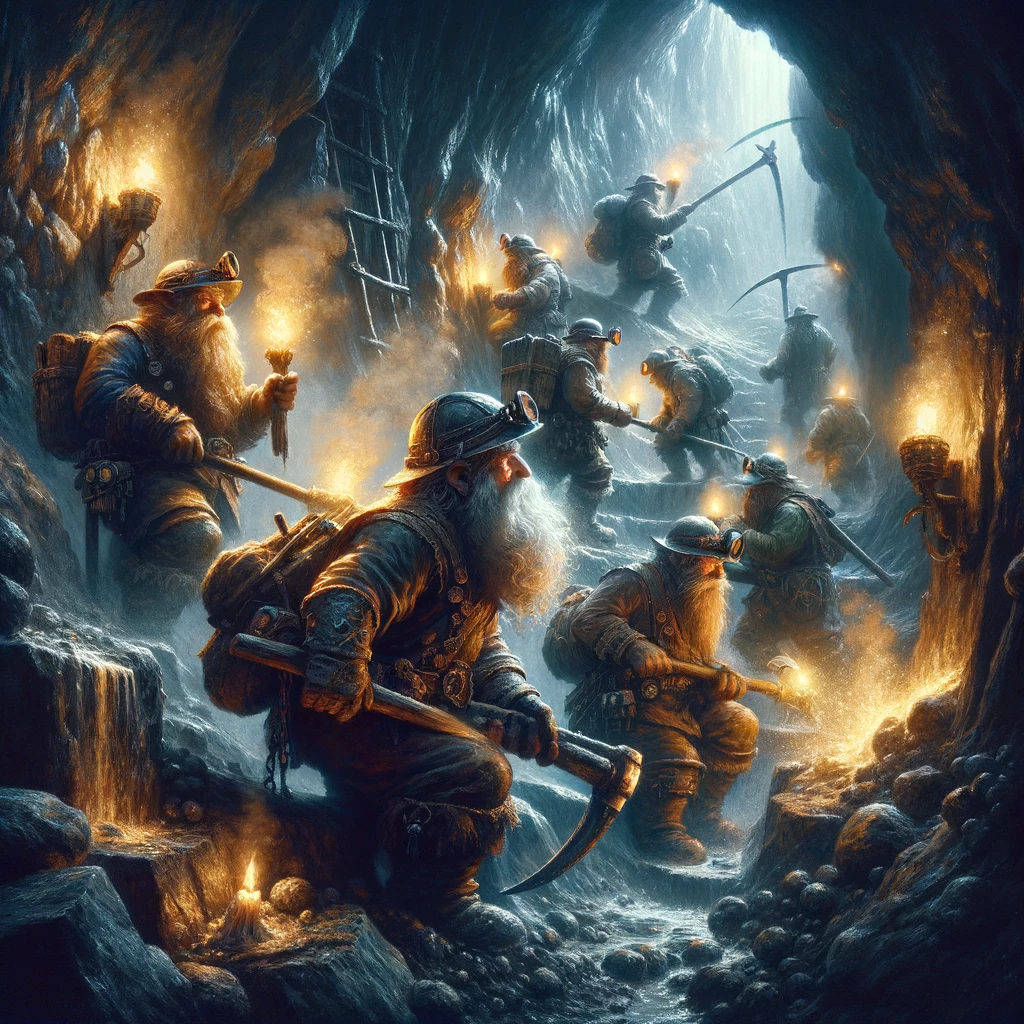
Mages can research spells or develop items to find ore, using the items de-scribed above as guidelines. Of course, all magic flirts with peril. New spells might invoke the elemental plane of Earth, and powerful but miscast spells could unleash volcanoes, earthquakes, or malign beings from other planes.
Despite their lore, prospectors depend on luck. Some mines begin in farmers' fields when plows turn up metallic stones. Other veins are found after landslides or earthquakes, and once a wildfire melted ore near the grounds surface, causing rivulets of gold to trickle down a mountainside.
Humans did not practice scientific geology until the 19th century. However, in a fantasy world, different races may be intimately familiar with the patterns of ore placement underground. Drow and svirfneblin, among others, certainly know where the earth hides its metals. Prospectors might venture underground to beg the advice of such races, but might eventually fight these races bitterly. Surface and underworld miners often clash because each group desires the same resources. PCs digging down into ore beds might meet beings chipping their way up.
Deep-dwelling races know that the earth is formed in layers of stone and dirt, with new layers forming over the old. Veins of ore usually appear where something disrupts these layers, concentrating minerals in one place. For example, magma can squeeze its way into other stones, carrying ore with it. It forms vertical dikes, horizontal sills, blister like laccoliths, and vast, rippling batholiths. Diamonds collect in kimberlite pipes, cones of volcanic rocks that project upward. Tectonic plates also alter the geology of an area. A rising plate might lift metals or oil, creating a chain of ‚deposits along the edge of a continent.
Underground peoples might also know about oil. Petroleum collects where the layers of earth curve, forming a trough or a trap for it. Petroleum is likely the "flaming oil" adventurers hurl at monsters; the only oils in the Middle Ages came from animal or vegetable fat and were unsuitable as weapons. Perhaps fantasy warriors import their oil from the underworld. Dungeon explorers may grow rich trading in oil they recover. Petroleum deposits might also interest Oriental characters; the ancient Chinese drilled for oil and salt water with bamboo derricks. Some Chinese emperors tried to tax these wells, but rural landlords resisted by posting scouts who dismantled the drills before inspectors arrived.
Once prospectors discover a vein, they must evaluate it by assaying (testing) the ore. Miners often judged unknown ores by chewing them. They also suspended earth in water so it could be studied with color-changing slips of paper, like the litmus paper used by modern chemists. Roman craftsmen made this paper by dipping parchment in shoe-black. It turned green when exposed to vitriol, a sulfate often found with metallic ores.
When these tests seem promising, assayers then heated ore in crucibles. Pure metals melt smoothly and at precise temperatures. Medieval assayers used flammable compounds to measure the melting points of ores. The craftsmen knew the temperature at which the powdered compounds would, combust, so if a molten metal ignited them, that showed how hot the metal was. These tests also helped miners choose fluxes for smelting. Fluxes are substances that aid the separation of slag from pure metal in the smelting process. Different colors of smoke created during these tests suggested different chemicals for use as fluxes, and deep purple smoke meant that the ore needed no flux at all. Each such test had to be performed in a cupel, or dish of ashes. The ashes were especially pure so they did not absorb the metal. Assayers preferred ash burned from beech or other trees that grow slowly.
Experts on metallurgy did more than test mines. They hunted counterfeiters and set values for metals. Grossly adulterated gold (used in forged coins or as part of a fake gold-mine scam) turns black in a candle flame. More sophisticated counterfeit metals appear real but will not melt until treated with lead flux. Once an assayer determined that a metal was genuine, he tested it with a touchstone to reveal its purity. The sample was beaten into a needle shape and scratched against black slate until it left a streak. By looking at the mark, a learned metallurgist could determine the ratio of metals in any alloy.
The tools required for assaying cost 50 gp, more if pure ashes are unavailable. Masters should make this check in secret. If the character succeeds, he learns the exact purity of the ore or coin being tested.
Ore Quality
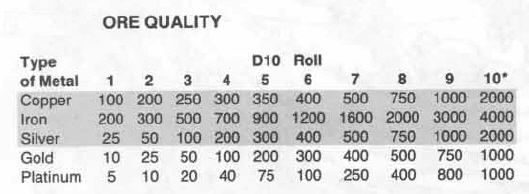
If the check fails, the assayer believes that the mine is either far more or far less valuable than it really is (there is a 50% chance of either result). PCs might then abandon a priceless mine or be convinced that a mine should be producing more than it does (and thus conclude that their workers are stealing ore).
Digging and Smelting Mines
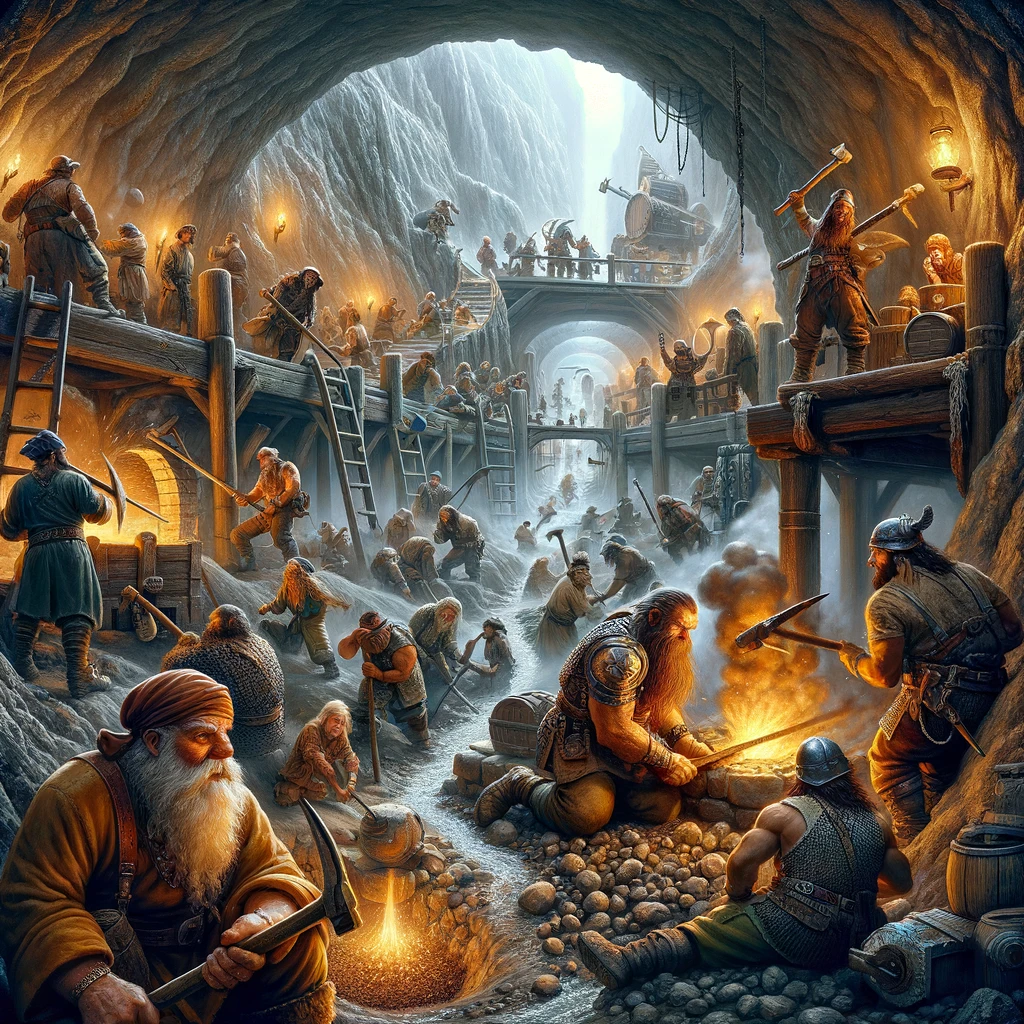
Determine a mine's output by calculating the amount of ore its workers can dig each day, using the table at the end of article: Mining Rates. Some magic, including dig and move earth spells and spades of colossal excavation, may speed the work.
The tables in this article's ending show how difficult ore is to dig, what it weighs, and how much metal can be extracted from it. Tables below can help determine other details, such as the location of veins and their composition. Remember that ore not only needs to be dug, but it must also be transported to a smelter, which we will talk about here in a few moments.
Ore appears in vertical columns called vena profunda, horizontal veins called vena dilatata, or lone masses called vena cumulata. Vena cumulata and vena profunda can be approached from above and are easy to excavate using vertical shafts. Miners dig vena dilatata while lying down; this keeps miners from wasting time digging useless stone but forces them to work in cramped positions, Dwarves excel at this job because they fit into these narrow tunnels. Larger miners can only mine these passages at 75% their normal rate, or one-half the normal rate if they insist on digging tunnels which they can't stand upright.
When characters smelt their ore, you will need to know how much metal the ore contains. Note: in real life, no one mined platinum until the 18th century. It was first found in riverbeds as part of a native alloy. This metal had to be dissolved in aqua regia and reprecipitated to form platinum. The exact methods used remain trade secrets for many, many years.
Once the ore is aboveground, it is sent though a new series of machines. Workers sort ore from stones by hand because plain earth soaks up metal when the two are placed in a furnace together. Each metal requires different treatment. Antimony (silvery-white metalloid) had to be treated gingerly, because alchemists warned that it might turn into lead. Pliny the Elder, a Roman naturalist, recommended mixing silver and gold ores, claiming that the electrum produced would create magical lightning and detect poison by turning black. When gold or silver mingles with lesser ores, acid is used to dissolve the unwanted metal. Adept miners could then reconstitute the other metals from solution. Some miners were even brave enough to dissolve the gold with a mix of hydrochloric and nitric acids, then precipitate it (check a basic chemistry text for details).
Gold can usually be washed out of its ore without heat or acid. There were an amazing variety of machines for purifying it, all based on the principle that gold is heavier than dirt and settles to the bottom when suspended in water. "Panning" by hand is the most basic version of this method. Other systems involved placing the ore on a screen with a tray underneath and running water over it, or lining streambeds with collector plates. Workmen patrolled these chutes with hoes to push lumps of gold back into the plates if they were washing away.
Ore that is to be smelted in a furnace must first be crushed. Some mine owners employed men with hammers to beat the stones, but mines with nearby streams used water wheels to power huge automatic hammers or grindstones to grind soft ore like wheat. (Orcs or other foul creatures might enjoy pounding people in this machinery.) Smelters roasted ore in open fires to burn away sulfur and bitumen before placing it in the furnace. In the smelter, ore was mixed with appropriate fluxes to make metals melt easily and at regular temperatures. Copper will not melt until all traces of iron with it have melted, so it is never worked with iron tools. Most furnaces required large bellows or mechanical blowers, and some were so large that operators needed cranes to open them. However, even these furnaces were not always large enough. A few miners preferred to build hills of ore against windy mountainsides and smelt hundreds of tons at once. Other smelters completely automated the process of refining metal, using water-powered conveyor belts and engines to crush, rinse, strain, and heat the ore.
It is always worthwhile to recycle processed ore. Some smelters accepted their slag instead of a fee, knowing that the slag still contained valuable metal. In the case of gold, even the water that washed it remained precious. Many miners strained gold dust from waste water with sheep's wool, and Agricola suggested that this was the origin of the Greek myth concerning the Golden Fleece. Clever miners could always extract even more gold by mixing mercury with the ore. Smelters put the most promising pieces of stone in a cloth bag with mercury and squeezed the bag until the quicksilver trickled out. The material left inside appeared to be pure gold; it was actually an amalgam, but not even experts could tell.
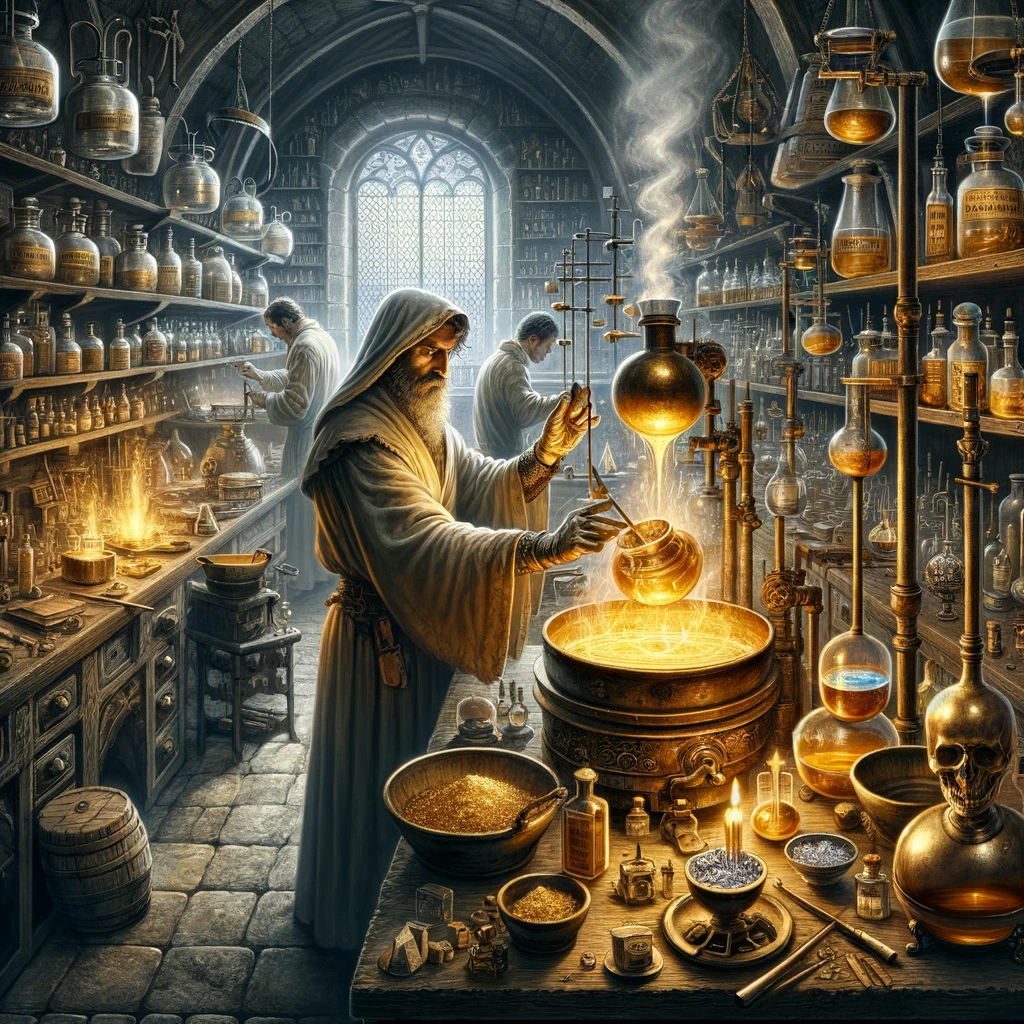
An alchemist could also use quicksilver to separate gold from silver. The process involved heating a gilt object in mercury, then rapping it sharply. All gold would crumble off, leaving the surface below intact. Other chemists used a powder of sal ammoniac and sulfur that could be applied to an object with oil. Gold would then flake away as soon as the object was heated. These methods were usually used by craftsmen who wanted to remake fine gilt items, but they have obvious applications for theft. A dose of this solution costs 50 gp and can remove 10 lbs. of gold.
Eventually, miners will have dug all the metal they can safely take from a mine. During Roman times, people hoped that ore would grow back in an exhausted mine, as if the earth were a living thing healing its wounds. This might be true on the elemental plane of Earth in a fantasy world. However, even Agricola knew that this was wrong, and he warned that no one should abandon a mine without leaving a record of why it was unsuitable. Many miners wasted fortunes trying to reopen empty mines. Mines in fantasy could be abandoned because of gases or monsters, or because the shafts had nearly tapped underground lakes or magma. But many an adventure might unfold as unknowing characters make their way through old shafts and tunnelings, in search of dangerous beasts or lost and forgotten riches beneath the ground.


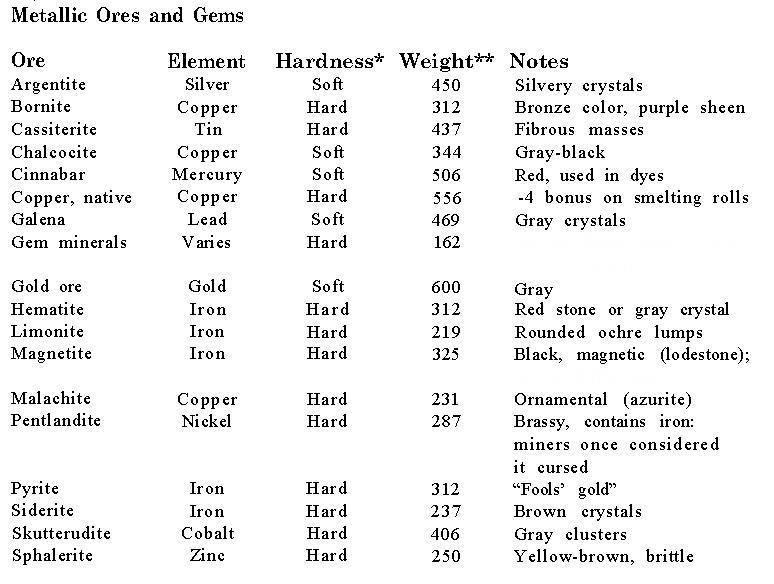
Mine and Dig
Perhaps the most valuable of all natural underground resources are the stones and metals found by miners. Mined resources of the underworld contribute greatly to life on the surface. Strong metals like copper and iron are necessary elements of blacksmithing, while valuable stones and metals like emeralds, rubies, and gold are all highly prized.
Where to Mine
A wide variety of regions could yield something of value to the intrepid miner. As a general rule, a character with miner proficiency stands a chance equal to his Wisdom score (plus his miner proficiency modifier) of finding something of worth where he elects to dig. Certain areas do not yield anything of value, regardless of the success of the proficiency roll. Examples of areas where mining is a waste of time include regions of deep sand or dirt, or areas of hardened lava.
Of course, streams flowing through such regions might have brought traces of a valuable ore or a gemstone, but mining the ground itself is virtually guaranteed to yield nothing in these areas. If a character with miner proficiency seeks to mine an area that the Master believes might yield valuable material, the character can make a Proficiency Check after thoroughly searching the area. Such a search requires at least a week of time under good searching conditions, and generally covers an area about four miles square. Good searching conditions mean that the character cannot be fending off bandits or hunting for food while he is searching.
A deep snow cover makes such a search impossible, while even a thin coating of snow doubles or triples the time needed to search an area. Steady rainstorms, rough terrain, and even the short hours of daylight typical in wintertime can all interfere with the would-be miner's search. When these or other adverse conditions exist, the Master must decide how much additional time is required before the area is suitably searched. After this search is completed, the player is allowed to make a Proficiency Check for his character. If the roll is unsuccessful, so is the miner's search. He can repeat his search of the same area if he wants to, but the task grows more difficult.
Types of Mines
The types of mines that are commonly encountered in a fantasy world include placer mines and underground (or tunnel) mines. The strip mining common in the modern age requires heavy equipment not found in the typical fantasy role-playing game campaigns. Placer mining involves sifting gravel, dirt, sand, and water from a flowing stream or river. Most commonly employed above ground, placer mining is a relatively simple mining operation. At its most basic level, the only requirements are a character with a shallow pan and a great deal of patience.
A placer mine gathers the mineral content of an underground vein of metal that has been eroded by water and has flowed downstream. It finally collects in some part of the streambed, where the miner separates it from the water. Because only the mineral wealth that has been eroded from the ground collects along the streambed, placer mining is not the way to discover a lode of significant value. Operating an underground, or tunnel, mine requires a great deal more work than a placer mine-but the potential for wealth is much greater.
An underground mine consists of a tunnel excavated into the earth. The rock that is dug from the tunnel is examined for riches. Because this post deals solely with the underground, the rules on mining deal primarily with tunnel mining. Of course, placer mining is still possible along underground streams, but underground characters and creatures are much more likely to labor in the lucrative tunnel mines.
Shoring A Tunnel
A tunnel mine must be regularly protected with wooden or stone support pillars, called shoring, or else sections of the tunnel will almost certainly cave in. Shoring can be accomplished by characters with carpenter, stonemason, or miner proficiencies. As a general rule, each 10-foot section of tunnel requires two side braces and a ceiling brace. If the tunnel is the standard 10 feet wide and 10 feet high, this takes 30 feet of bracing that is at least one foot in diameter. Each set of shoring supports takes four man-hours to construct. Unless the character doing the shoring is extremely strong (18 or greater strength), moving the braces into the mine requires additional manpower or animal help.
Mine Contents
Many minerals can be found in mines. The list in not complete, but here is an example: copper, tin, lead, iron, silver, gold, platinum, mithril, gemstones and much more.
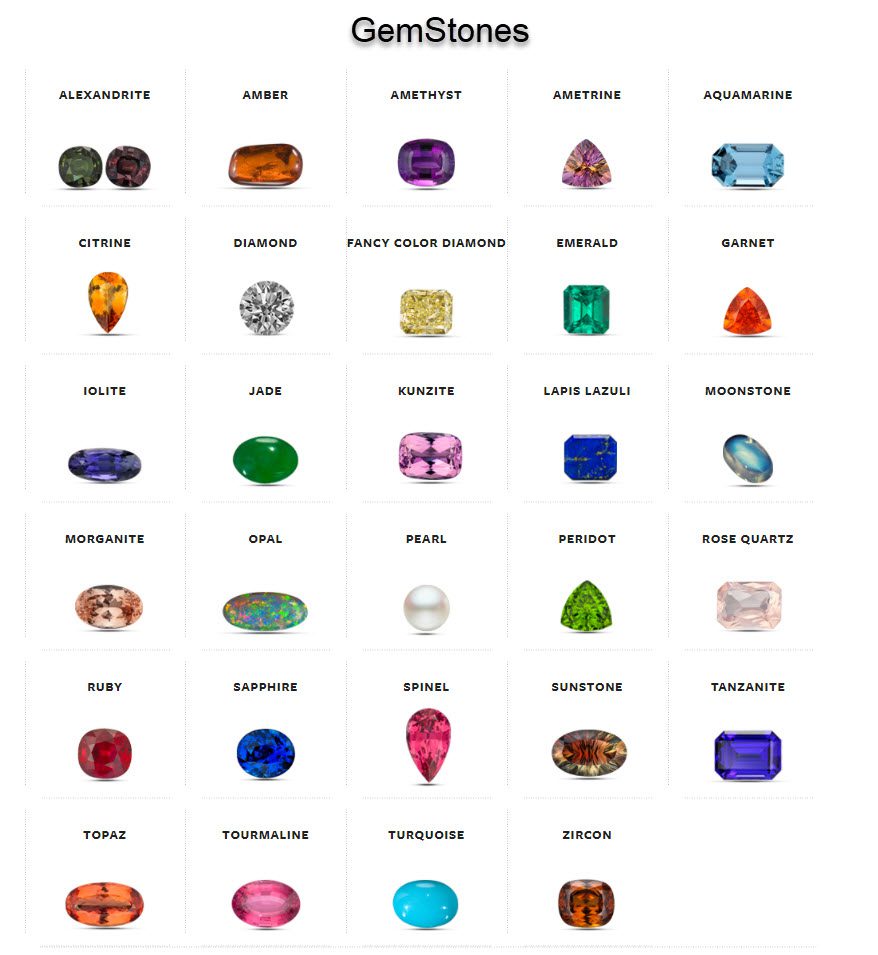
Just as the mined metal is in a rough form, gemstones fresh from the mine are not nearly as valuable as they are after finishing. Gemstones are rough and often unrecognizable when first discovered.
Quality of Mine and Metals
The fact that gold has been found in a mine does not mean that a character can immediately begin to gather up armloads of gp and head for the moneychanger! First, the quality of the ore must be determined. Even the highest quality metals usually require some processing or purifying before they can be sold for their full value. If the product of a mine is a metal, the mine usually yields the metal in its ore form; that is, heavily mixed with rock.
A very pure vein that yields nuggets of pure metal may occasionally be discovered, but generally a character with smelter proficiency must process the ore to its pure metallic state. The quality of the metal or ore equals the number of coins that can be produced from the metal mined by a single miner in a week. For example, a copper mine with a rating of 200 cp means that a single miner working the mine for a week produces a pile of ore that, when smelted, yields a grand total of 200 cp.
List of Metals Comparative Value to Gold (cheapest to most expensive):
| Metal | Cost (Gold Pieces) | Properties |
|---|---|---|
| Copper | 0.5 | Common, easy to work with |
| Tin | 1 | Common, often alloyed |
| Iron | 1 | Common, susceptible to rust |
| Zinc | 1 | Common, often used in alloys |
| Lead | 2 | Heavy, toxic |
| Pewter | 2 | Alloy, low melting point |
| Bronze | 2 | Alloy of copper and tin, corrosion-resistant |
| Brass | 3 | Alloy of copper and zinc, decorative |
| Nickel | 4 | Resistant to corrosion, often used in alloys |
| Steel | 5 | Alloy of iron, stronger and less prone to rust |
| Silver | 50 | Precious, conducts energy, magical and ritualistic uses |
| Electrum | 60 | Alloy of gold and silver, often used for coinage |
| Gold | 100 | Precious, soft but highly ductile, magical uses |
| Mercury | 200 | Liquid at room temperature, toxic, magical uses |
| Platinum | 500 | Precious, highly resistant to corrosion |
| Alchemical Silver | 600 | Specially treated, effective against lycanthropes |
| Darksteel | 800 | Resilient, absorbs vibrations |
| Mithral | 1000 | Lightweight, strong, magic-enhancing |
| Adamantine | 2000 | Nearly indestructible, provides superior damage resistance |
| Cold Iron | Varies (~2000-5000) | Harmful to fey and some outsiders, magical properties |
| Fey Iron | 2500 | Infused with fey magic, advantageous against certain creatures |
| Thinaun | 3000 | Absorbs souls, very rare |
| Orichalcum | 3000 | Mythical, amplifies magic |
| Dragonmetal | 4000 | Rare, magical properties vary based on dragon origin |
| Ebonite | 5000 | Absorbs magic, rare |
| Fae Metal | 5000 | Exotic, reacts unpredictably with magic |
| Starmetal | 10,000 | Otherworldly, incredibly rare, unpredictable magical properties |
| Astral Driftmetal | 15,000 | Found in astral plane, lightweight and durable |
| Planar Alloy | 20,000 | Combines properties of metals from different planes, incredibly rare |
| Celestial Gold | 25,000 | Originates from celestial planes, strong affinity with divine magic |
| Hellforged Steel | 30,000 | Infused with infernal energies, effective against celestials |
| Void Metal | 50,000 | Absorbs light and magic, extremely rare and dangerous |
Metallurgy: Combination of Metals (with results)
| Base Metal | Added Element(s) | Resulting Alloy | Common Uses |
|---|---|---|---|
| Copper | Zinc | Brass | Decorative items, fittings, instruments |
| Copper | Tin | Bronze | Statues, bearings, historical weapons |
| Iron | Coal (Carbon) | Steel | Construction, tools, automotive |
| Lead | Tin | Pewter | Decorative items, tableware |
| Aluminum | Magnesium | Al-Mg Alloy | Aerospace components |
| Nickel | Chromium | Nichrome | Electrical heating elements |
| Gold | Copper | Gold Alloy | Jewelry |
| Tungsten | Carbon | Tungsten Carbide | Cutting tools |
| Titanium | Aluminum, Vanadium | Ti-Al-V Alloy | Aerospace, medical devices |
| Cobalt | Chromium | Co-Cr Alloy | Medical implants |
| Zinc | Aluminum | Zamak | Die casting |
| Silver | Copper | Sterling Silver | Jewelry, tableware |
| Copper | Nickel | Cupronickel | Coins, marine engineering |
| Iron | Carbon, Chromium | Stainless Steel | Kitchenware, construction |
| Magnesium | Aluminum | Mg-Al Alloy | Car parts |
